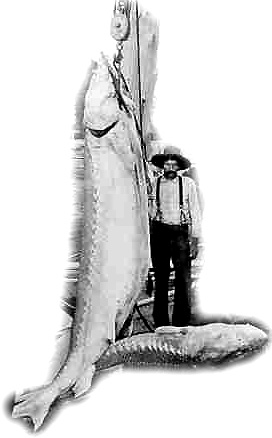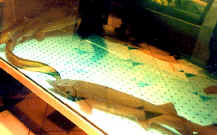
The sturgeon is a legendary
prehistoric armor-scaled fish that can live to be more than 100 years old
and have been caught weighing 3000 pounds. In fact many think that the Loch Ness monster is a giant sturgeon which would explain the dragon-like
ridges or fins along the back and in the Native American legend of
Hiawatha it is said that he was swallowed by a sturgeon.
 Famous
for their roe, made into caviar, the lean flesh is firm and many say it
has the texture of chicken breast. The flavor can at times be muddy or
earthy but its mild flavor makes it a great candidate for the table.
Famous
for their roe, made into caviar, the lean flesh is firm and many say it
has the texture of chicken breast. The flavor can at times be muddy or
earthy but its mild flavor makes it a great candidate for the table.
Its firm white meat resembles that of shark but the
sturgeon is really a member of the Cod Family. The
sturgeon lives half of its life in fresh water and half in salt water.
There are 24 different species of
sturgeon found in Russia, Northern Europe, Asia, the United States and
Canada. All sturgeons have a cartilage skeleton, five rows of bony
plates on their bodies instead of scales, thick lips, and four sensory
barbs in front of the mouth for detecting food.
Sturgeon may be poached, smoked, pan-fried or broiled. It is
considered a delicacy when smoked.
All the parts of the fish are
used, the roe for caviar, the air bladder of the beluga is taken for
isinglass which is a gelatin used for binding cold dishes, and the spinal
marrow (vesiga) is dried and used to make Russian pies and pates.
Of the seven North American species only two the white
and green remain in quantities to be commercially harvested.